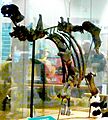Armley Hippo facts for kids
| Common name | Armley Hippo |
|---|---|
| Species | Common hippopotamus (Hippopotamus amphibius) |
| Age | 130,000 to 117,000 years (Ipswichian interglacial period) |
| Place discovered | Longley's brickfield, Wortley, Armley, Leeds, West Riding of Yorkshire, England |
| Date discovered | 1851–1852 |
| Discovered by | Brick pit workmen |
| Displayed at Leeds City Museum | |
The Armley Hippo, also known as the Leeds Hippopotamus, is a famous fossil of a common hippopotamus. It's made up of 122 bones, and 25 of them are put together like a puzzle for everyone to see. You can find it displayed at Leeds City Museum in Leeds, West Yorkshire, England. This ancient hippo lived a very long time ago, about 130,000 to 115,000 years ago, during a warm period called the Eemian interglacial.
The bones were found by workmen digging clay for bricks in Armley, Leeds, between 1851 and 1852. The discovery was a big deal because it's rare to find hippo bones so far north in the world. The Armley Hippo has always fascinated people and is still used today to teach us about prehistoric times.
Contents
Discovering the Ancient Hippo
How the Bones Were Found
In 1851, workmen were digging clay at Longley's brickfield in Wortley (which is now part of Armley). They found some really big fossil bones and were very surprised by their size! They brought the largest bones to Henry Denny, who was the curator (or manager) of the Leeds Philosophical Society's museum.
Henry Denny then visited the brickfield himself and found many more bones. Sadly, some of the smaller bones had already been lost or damaged. Along with the Armley Hippo, bones from three other hippos, a woolly mammoth, and an aurochs (an ancient type of wild cattle) were also found at the site. In 1852, even more hippo bones were discovered there.
Why the Find Was Important
Finding hippo bones in Yorkshire was very exciting for people in the Victorian era. It was unusual to find remains of hippos so far north in the world. The Leeds Museum became known for having one of the largest collections of hippo fossils outside of London.
Scientists thought that during a time when the climate was much warmer, and some continents were joined, hippos or their ancestors might have traveled north from Africa along rivers to the land that is now England. It's even thought that early humans might have lived at the same time as some of the hippos found in Yorkshire.
What is the Armley Hippo?
The Armley Hippo skeleton is from a type of hippo called Hippopotamus amphibius, which is the same species as modern hippos, but this group lived over 100,000 years ago and is now extinct in the UK.
Out of the 122 bones found, only 25 of them are put together and displayed in the museum. These 25 bones make up the left side of the hippo's skeleton, not including its head. The rest of the bones are kept safely in the museum's storage. It's very rare to find such a large part of an ancient hippo skeleton in the UK; usually, only a few bones are found. The Armley Hippo is the most northerly (furthest north) ancient hippo specimen ever found in the UK.
How Old Are the Bones?
For a long time, it was hard to figure out the exact age of the bones. This was partly because a special coating, possibly gelatin, had been added to them when they were first found.
More recently, scientists were able to test a tooth from the skeleton. They found that the Armley Hippo lived about 130,000 to 117,000 years ago. This was during a warm period called the Ipswichian interglacial period, when the climate was perfect for hippos to live in Britain.
Modern science suggests that hippos have lived in Britain off and on during different warm periods between ice ages.
Displaying the Armley Hippo
When the bones were first found, they were simply laid out on tables for people to see. For example, in 1853, they were shown at a special event for the Leeds Philosophical Society.
In 2008, 25 of the bones were carefully put together by a specialist named James Dickinson. This mounted skeleton is now a popular exhibit at Leeds City Museum. Brian Selby from Leeds City Council said it's amazing to think that hippos once lived in Leeds and that this fossil helps us imagine what the world was like so long ago.
In 2022, the skull of another ancient hippo, which had been given to Leeds Museum, was prepared for display. It will be shown alongside the Armley Hippo, giving visitors an even better look at these incredible prehistoric animals.
Pavement Plaque
You can find a special plaque on the pavement outside 81 Town Street in Armley. It marks the discovery of the hippo bones, though it's not exactly where the original find happened. The plaque says the discovery was in 1852, which was when bones from two hippos were found. However, bones from four hippos were found in 1851. It's possible that bones from the same hippo were found over both years, as the museum curator Henry Denny dug there multiple times.
See also
- Allenton hippopotamus fossil H. amphibius specimen from Derby
Images for kids









